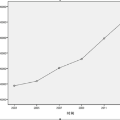We study the problem of graph structure identification, i.e., of recovering the graph of dependencies among time series. We model these time series data as components of the state of linear stochastic networked dynamical systems. We assume partial observability, where the state evolution of only a subset of nodes comprising the network is observed. We devise a new feature vector computed from the observed time series and prove that these features are linearly separable, i.e., there exists a hyperplane that separates the cluster of features associated with connected pairs of nodes from those associated with disconnected pairs. This renders the features amenable to train a variety of classifiers to perform causal inference. In particular, we use these features to train Convolutional Neural Networks (CNNs). The resulting causal inference mechanism outperforms state-of-the-art counterparts w.r.t. sample-complexity. The trained CNNs generalize well over structurally distinct networks (dense or sparse) and noise-level profiles. Remarkably, they also generalize well to real-world networks while trained over a synthetic network (realization of a random graph). Finally, the proposed method consistently reconstructs the graph in a pairwise manner, that is, by deciding if an edge or arrow is present or absent in each pair of nodes, from the corresponding time series of each pair. This fits the framework of large-scale systems, where observation or processing of all nodes in the network is prohibitive.
翻译:本文旨在研究图结构识别问题,即如何恢复时间序列之间的依赖关系图。本文将这些时间序列数据建模为线性随机网络动力学系统状态的组成部分。本文假设只能观测到组成网络的子集节点的状态演化,即部分可观测性。本文提出了一种新的特征向量,该向量是从所观测的时间序列中计算得到的,并证明了这些特征是线性可分离的,也就是说,存在一个超平面将与连接节点对应的特征聚簇与未连接节点对应的特征聚簇分开。这使得这些特征适合训练各种分类器以进行因果推断。特别地,本文使用这些特征来训练卷积神经网络 (CNN)。由此得出的因果推断机制在样本复杂度方面优于现有的同类方法。所训练的 CNN 对结构不同的网络 (密集或稀疏) 和噪声水平表现出良好的泛化能力。令人惊讶的是,它们还可以在使用合成网络 (随机图的实现) 进行训练的同时,在实际网络上良好地进行泛化。最后,该方法能够以成对的方式一致地重构图,即通过对应的每对时间序列决定每对节点中是否存在边缘或箭头。这适用于大规模系统的框架,其中观察或处理网络中的所有节点是不可行的。

